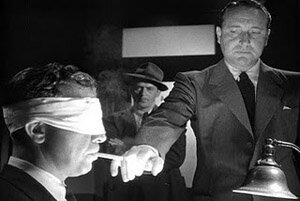

In the 1930, Los Angeles was an extraordinarily corrupt city. A columnist in TIME referred to the city as the slobbering civic idiot of American municipalities. Police and fire commissions were being sold. Author Raymond Chandler artfully depicted a police force riddled with sloth and bribery, only slightly less bad than the hideous "Bay City" police in his Philip Marlowe novels. A serious reform movement in the late 1930s seemed to bring things under control, then just as TIME appeared to revise its view of LA in 1949, a scandal involving a prostitution ring operating inside of the LAPD threatened to revive the image of the LAPD of Raymond Chandler. (The picture above is a depiction of an LAPD interrogation in the movie Murder My Sweet appearing on the website piddleville.com)
In this sordid environment, the Los Angeles Police Commission appointed William H. Parker as it's Chief. And something remarkable happened. Within a handful of years, Parker had cleaned up the LAPD, so that by the mid 1950s it was being looked to as a model of police professionalism. The picture above right is Parker, as taken from the official LAPD website.
How did this happen? How was Parker able to steward such a remarkable and rapid turnaround? What are the implications for the elimination of corruption in the developing world. Doug and I have a new paper: "Just the Facts Ma'Am: A case Study of the Reversal of Corruption in the Los Angeles Police Department," looking at these questions.
Background reading is tedious, but background watching can be fun. So the question is: what do these fictional characters have in common? (Sgt. Friday is from the official LAPD website, Mr. Spock is from Wikipedia, Ed Exley is from this review of L.A. Confidential in Slate.com.)



No comments:
Post a Comment